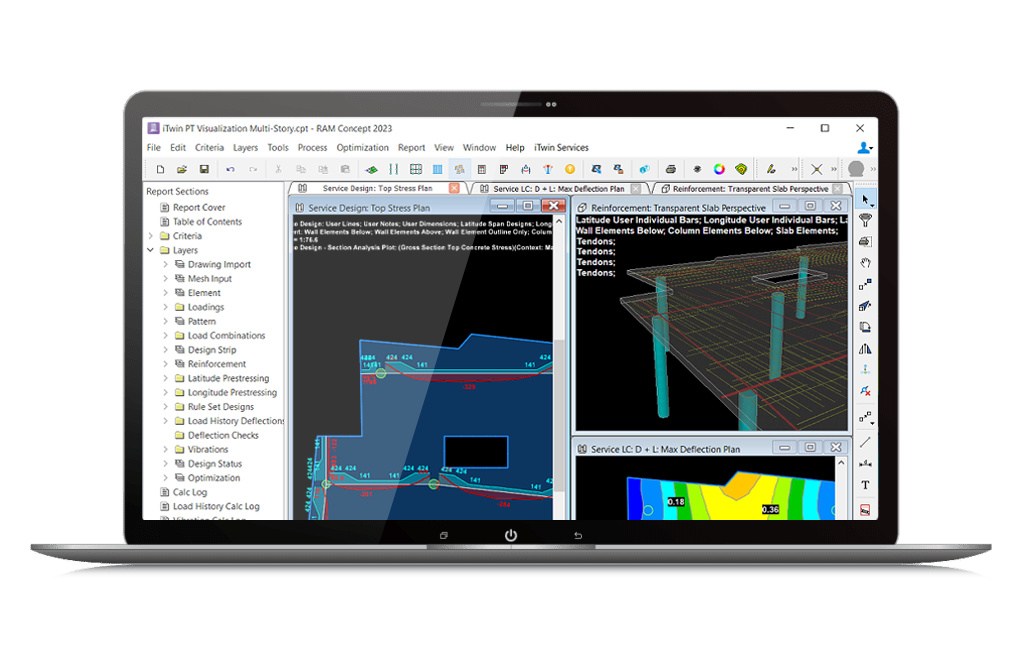
RAM Concept
Concrete Slab Design Software
The Go-To For Concrete Slab And Foundation Design
Economically design post-tensioned and reinforced concrete floors
RAM Concept is structural software for the design of post-tensioned and reinforced concrete floors including slabs, mats, and rafts. It provides exceptional visibility into compliance, efficiency, and practicality. Design floors and foundations reliably and efficiently, saving time and money, and overcoming the most common concerns you face as a designer. RAM Concept allows you to easily design complex floor geometries and incorporate changes with ease using powerful task automation and clearly organized output.

Design
Optimize Post-Tensioned Concrete Floor Designs
Optimize the design of post-tensioning, reinforcement, and studded shear reinforcement for post-tensioned concrete floors using cloud-based optimization. Save engineering time by letting the optimizer sort through thousands of design alternatives and have confidence that your post-tensioned design has reduced material and labor costs.
Design Raft Or Mat Foundations To International Standards
Design using soil springs and a zero-tension analysis. Confidently complete your designs with the extensive support of international standards.
Design And Analyze With Finite Elements
Complete building analysis, design, and drafting with finite element analysis. Reduce time spent waiting for results with fast solvers.
Analyze
Analyze Gravity, Lateral, And Temperature Loads
Design and analyze simple or complex concrete floors for a wide range of loading conditions, including skip live loads, wind/seismic loads, and temperature loads.
Analyze Deflections For Time-Dependent Effects
Capture time-varying properties of concrete in your analysis. Account for creep, shrinkage, and cracking at various stages in the analysis, accurately predicting deflections with consideration for how concrete truly behaves.
Analyze Floors For Walking Vibration
Study dynamic behavior, including resonant and impulsive effects, of simple and complex concrete floors due to walking vibration. Evaluate sensitivity criteria for occupants or sensitive equipment.
RAM Concept is the ultimate structural design solution for post-tensioned (PT) and conventionally reinforced slabs, mats, and rafts. RAM Concept empowers structural engineers to design floor systems cost effectively and with exceptional visibility into the compliance, efficiency, and practicality of the design. RAM Concept interoperates with many engineering applications and formats, enabling an engineer’s work to extend to other purposes during a project, including building information modeling, documentation, and collaboration with other structural designers.
SLAB DESIGN FOR THE PRACTICING ENGINEER
Bentley developed RAM Concept with the practicing structural designer in mind. Several key features automate time-consuming tasks engineers must perform, including automatic layout of tendons, design spans, and column and middle strips. Modeling commands enable fast floor rework when geometric revisions are necessary. You can easily access a wealth of information and results using a well-organized, layer-themed interface. Both auto-design and specify-check methods are available, with the ability to override any program-selected design entities.
The cloud-based PT slab optimization feature uses high-powered search algorithms to automatically search thousands of possible solutions, eliminate solutions that fail design code criteria, and identify the design option that minimizes the total material and labor cost of post-tensioning, mild reinforcement, and studded shear reinforcement. This feature reduces engineering design time by eliminating the need for tedious manual iteration while generating significant cost savings for your projects.
REALISTIC TENDON MODELING
With RAM Concept, you can model tendons in their true three-dimensional positions. Models of banded, distributed, or arbitrary tendons with virtually any profile can be easily created. RAM Concept’s tendon loading analyses consider full 3D hyperstatic (secondary) effects, including restraint from shear walls and stiff columns. These features facilitate a better understanding of the effects of tendons on the slab.
ACCURATE PUNCHING SHEAR ANALYSIS AND DESIGN SOFTWARE
RAM Concept can check punching shear capacity for any irregular slab geometry. It automatically designs studrails as required, eliminating the time needed to simplify real punching geometry into standard interior, edge, and corner conditions. Punching shear can be checked and reinforcements designed at columns below slabs and at transfer columns on floors and mats/ rafts. These capabilities can save a day of design time on every slab.
ACCURATE ANALYSIS OF LONG-TERM SLAB DEFLECTIONS
RAM Concept features load history analysis, a method for calculating deflections with accurate consideration of time-dependent material behavior, cracking, and load history. The application considers the effects of cracking, creep, shrinkage, tension stiffening, and load sequence. Implemented creep and shrinkage models include the models outlined in ACI 209.2, AS 3600, and EC2. RAM Concept rigorously calculates curvature induced by internal restraint to shrinkage from reinforcement and can approximate cracking caused by external restraint to shrinkage from stiff supports. Important calculated parameters are tabulated for each cross section for quick review and verification. The load history feature provides the precision needed to assess long-term deflections accurately while keeping run time and processing demands within reason.


RAM Concept At-A-Glance
TECHNICAL CAPABILITIES
- ACI 318-99 through ACI 318-19
- AS 3600-2001 through AS 3600-2018
- Eurocode 2-2004
- BS 8110-1997 with TR 43
- CAN/CSA A23.3-04
- IS 456-2000
- Elevated slabs (one-way, two-way, and waffle slabs)
- Podium slabs or transfer plates
- Beam/slab systems (pan joists, beams, and girders)
- Mat/raft foundations
- Post-tensioned and/or reinforced concrete
- Drop caps, panels, and slab steps of any shape
- Openings of any shape at any location
- Wall, column, point spring, and line spring supports
- Meshed rigid support zones at columns and wall supports
- Zero-tension area springs to model soil
- Imported CAD drawing as a snapping background
- Automated meshing
- Program-generated or unlimited user-specified load combinations for each design code
- Load patterns of any shape
- Lateral self-equilibrium loadings for integrating 3D building analysis results with RAM Concept’s floor analysis
- Temperature and shrinkage strain loadings
- Calculate long-term deflections that consider cracking, creep, shrinkage, and load history
- Calculate walking-induced vibration response (vibration modes, peak acceleration, and velocities)
- Customizable, professional reports
- Audit reports with detailed design calculations for design sections and punching shear checks
- Calculation result tables with spreadsheet export option
- Model banded, distributed, and arbitrary tendons (bonded or unbonded) with virtually any profile
- Rapidly generate tendons or define tendons manually
- Specify effective tendon forces or consider varying tendon forces with program-calculated friction losses
- Automatically calculate tendon loadings along profiles, including horizontal sweeps
- Design for 3D hyperstatic (secondary) effects
- Check precompression limits and plot average precompression across design strips
- Optimize post-tensioned floors to reduce total tendon, reinforcement, and SSR costs
- Design with auto-selected program reinforcement or check designs with user-specified reinforcement only
- Specify a uniform mesh of reinforcing over an area and design with additional required program reinforcement
- Automatically calculate development lengths with program-detailed hooks
- Enforce custom span detailing preferences
- Export steel reinforcement to Revit through Bentley’s iTwin® Analytical Synchronizer
- Generate design spans/strips automatically for the entire floor, with the ability to manually revise
- Post-tensioned, reinforced, and hybrid concrete design
- Consider minimum, strength, initial service (transfer of pre-stress), service, and ductility design code requirements
- Complete cracked section analyses using appropriate material stress-strain curves for each component
- Design for twisting moments (Mxy) using Wood-Armer or other methods
- Retrieve an exhaustive design echo for each cross section using the auditor tool
- Tools that simplify the process of identifying| locating| and fixing design errors
- Perform accurate punching shear analysis
- Generate critical sections automatically considering complex geometries
- Design for columns above or below the slab
- Consider biaxial moments
- Design with studded shear reinforcement (SSR)
- Check punching shear capacity for any slab geometry
- Reinforce columns below slabs and at transfer columns
- Simplify real punching geometry into standard interior| edge| and corner conditions
- Automatically design studded shear reinforcement (studrails) to save days of design time
- Compatible with Bentley Infrastructure Cloud, iTwin Design Review, and iTwin Analytical Synchronizer, which includes Revit integration
- Python scripting API
- Import/export of floor levels from/to RAM Structural System
- Import of structure and loadings from STAAD®
- Import and export of CAD drawings
FREQUENTLY ASKED QUESTIONS
RAM Concept is a structural engineering design software for concrete slabs, mats, and rafts that helps design floor systems in a more cost-effective way.
Processor
Multiple cores utilized but not required
Operating System
Windows 10 or later
RAM
1GB recommended Hard Disk 2.5GB free disk space
Display
256MB video card with DirectX 9 compatible (DirectX 10 compatible recommended)
For the most up-to-date system requirements, visit Bentley Communities.
